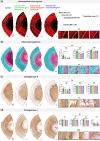Multiaxial rotational loading compromises the transition zone of the intervertebral disc: Ex vivo study using next-generation bioreactors
- PMID: 40708985
- PMCID: PMC12284434
- DOI: 10.1002/btm2.70033
Multiaxial rotational loading compromises the transition zone of the intervertebral disc: Ex vivo study using next-generation bioreactors
Abstract
Bioreactors have become indispensable tools in spine research, enabling long-term intervertebral disc culture under controlled biological and mechanical conditions. Conventional systems are often limited to uniaxial loading, restricting their ability to replicate the complex, multidirectional biomechanics of the spine. To overcome this limitation, we developed a next-generation bioreactor capable of simulating multiaxial motions while preserving the disc's biological environment. In this study, we investigated the effects of complex loading patterns on early disc degeneration by subjecting bovine whole-organ discs to combined extension, lateral bending, and torsion at 0.3 Hz for 2 h daily over 14 days. To assess the impact of loading magnitude and the specific contribution of torsion, discs were exposed to either low- or high-angle rotations, with or without torsional loading at higher angles. Histological analysis revealed a marked loss of glycosaminoglycans (GAG) and collagen type II within the inner annulus fibrosus and transitional nucleus pulposus (NP), encompassing the transition zone (TZ), as well as GAG depletion in the central NP. Matrix degradation was observed across all loading conditions, with the most severe breakdown occurring under high-angle extension, bending, and torsion. All loading regimes induced cell death in the TZ and central NP, although torsion-free loading better maintained cell viability. These findings highlight the TZ, alongside the commonly affected NP, as a critical early site of degeneration. The study further underscores the importance of incorporating multiaxial loading in disc degeneration models and provides new insights into the biomechanical mechanisms underlying disc pathology.
Keywords: bioreactors; intervertebral disc; multiaxial loading; transition zone; whole organ culture.
© 2025 The Author(s). Bioengineering & Translational Medicine published by Wiley Periodicals LLC on behalf of American Institute of Chemical Engineers.
Conflict of interest statement
All authors declare that they have no conflicts of interest with respect to this work.
Figures






Similar articles
-
Therapeutic effects of PDGF-AB/BB against cellular senescence in human intervertebral disc.Elife. 2025 Jul 16;13:RP103073. doi: 10.7554/eLife.103073. Elife. 2025. PMID: 40668091 Free PMC article.
-
The "horizon gray band" represents normal nucleus pulposus cells condense rather than intervertebral disc degeneration signal.Int J Surg. 2025 Jul 1;111(7):4339-4353. doi: 10.1097/JS9.0000000000002532. Epub 2025 May 26. Int J Surg. 2025. PMID: 40422293
-
Suspension bioprinted whole intervertebral disc analogues enable regional stiffness- and hypoxia-regulated matrix secretion by primary human nucleus pulposus and annulus fibrosus cells.Acta Biomater. 2025 Jun 15;200:378-389. doi: 10.1016/j.actbio.2025.05.015. Epub 2025 May 7. Acta Biomater. 2025. PMID: 40339969
-
Systemic pharmacological treatments for chronic plaque psoriasis: a network meta-analysis.Cochrane Database Syst Rev. 2021 Apr 19;4(4):CD011535. doi: 10.1002/14651858.CD011535.pub4. Cochrane Database Syst Rev. 2021. Update in: Cochrane Database Syst Rev. 2022 May 23;5:CD011535. doi: 10.1002/14651858.CD011535.pub5. PMID: 33871055 Free PMC article. Updated.
-
Systemic pharmacological treatments for chronic plaque psoriasis: a network meta-analysis.Cochrane Database Syst Rev. 2020 Jan 9;1(1):CD011535. doi: 10.1002/14651858.CD011535.pub3. Cochrane Database Syst Rev. 2020. Update in: Cochrane Database Syst Rev. 2021 Apr 19;4:CD011535. doi: 10.1002/14651858.CD011535.pub4. PMID: 31917873 Free PMC article. Updated.
References
LinkOut - more resources
Full Text Sources
Miscellaneous

